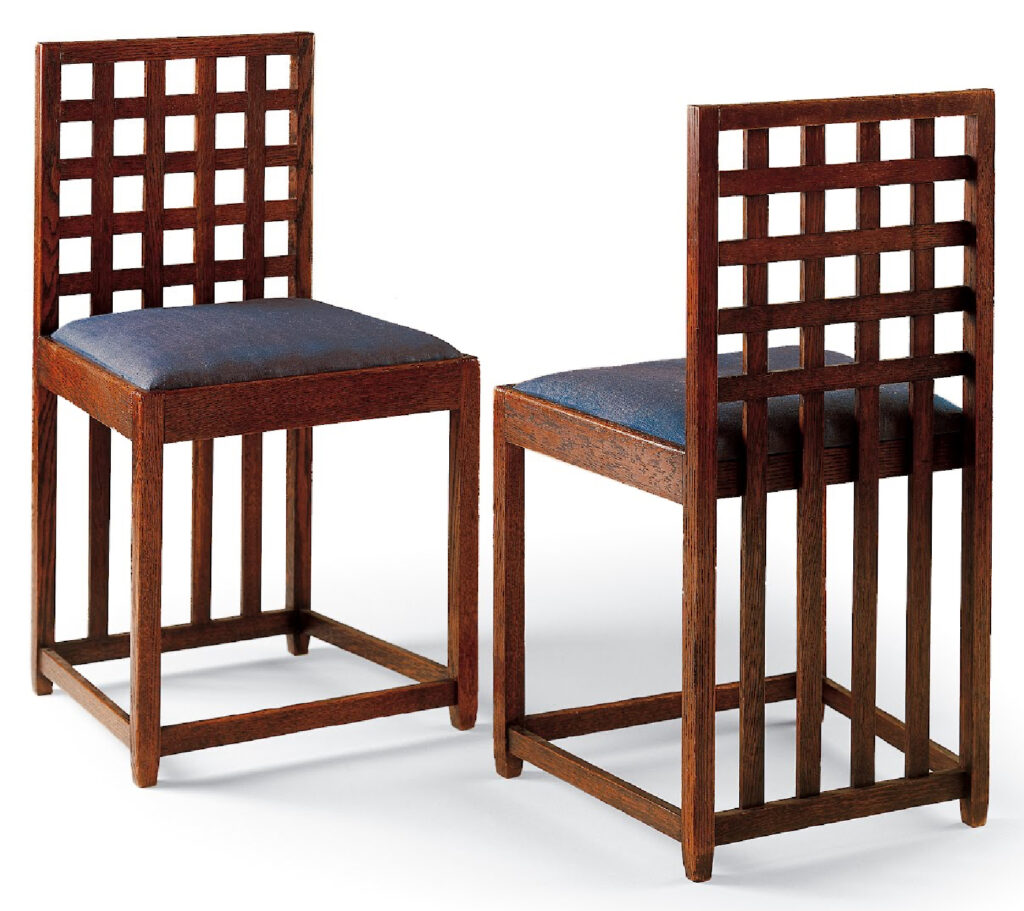The name Charles Rennie Mackintosh evokes a vision of timeless elegance, precision, and innovative design that continues to inspire contemporary creators over a century later. Known for his meticulous attention to detail and a philosophy that fused functionality with artistry, Mackintosh’s work remains an enduring benchmark for designers across disciplines. Among his celebrated creations are the Two Chairs for the Blue Bedroom at Hous’hill, which not only epitomize his design principles but also serve as a foundation for examining how his work resonates in today’s trends in furniture and interior design.
The Philosophy of Charles Rennie Mackintosh
Born in 1868 in Glasgow, Charles Rennie Mackintosh was an architect, designer, and artist who seamlessly blended Arts and Crafts ideals with early modernist sensibilities. His approach was grounded in the belief that every element within a space—furniture, decor, and architecture—should exist in harmony. This philosophy is evident in his works for private residences, such as the Blue Bedroom at Hous’hill, designed within collaborative effort with his wife, Margaret Macdonald Mackintosh.
Mackintosh’s furniture transcended mere utility. He imbued his pieces with symbolism, elegance, and a meticulous sense of proportion that rendered them timeless. His work on the Two Chairs for the Blue Bedroom reflects this ethos: while designed specifically for a bedroom, their minimalism and geometric clarity resonate far beyond their intended function.
The Blue Bedroom at Hous’hill: Symbolism and Design Harmony
Hous’hill, owned by Miss Catherine Cranston, was a significant project for Mackintosh. The Blue Bedroom exemplifies his ability to create a holistic space where every design element works together to evoke a particular mood. Blue, the dominant color in the bedroom, was chosen for its associations with calm, introspection, and spirituality, aligning with the private, restful nature of the space.
Furniture as a Reflection of Theme
The Two Chairs for the Blue Bedroom serve as integral components of this thematic design. Their restrained aesthetic and functional simplicity reflect the room’s serene atmosphere. Crafted from oak with linen upholstery, the chairs achieve a balance of durability and softness. Their compact dimensions make them perfectly suited for the bedroom while maintaining Mackintosh’s signature geometric precision.
The restrained elegance of these chairs demonstrates Mackintosh’s mastery of creating furniture that does not overpower its environment but instead complements it, enhancing the emotional resonance of the space.
Mackintosh’s Influence on Modern Furniture Trends
The timeless quality of Mackintosh’s designs is reflected in their continued relevance to modern furniture trends. Contemporary designers often draw inspiration from his principles, adapting them to new materials, technologies, and cultural contexts.
Minimalism with Character
Mackintosh’s ability to strip furniture down to its essential form while retaining its visual and emotional impact prefigures today’s minimalist trends. His clean lines and geometric forms are echoed in contemporary furniture that prioritizes simplicity without sacrificing individuality.
•Example Trend: Scandinavian design, known for its minimalist aesthetics and natural materials, shares a kinship with Mackintosh’s restrained yet expressive approach. Brands like IKEA and Hay frequently produce pieces that blend functional simplicity with subtle artistic flourishes.
Holistic Design
The idea of designing a space holistically, where furniture, color, and decor exist in harmony, remains a cornerstone of interior design. Mackintosh’s Blue Bedroom demonstrates how every element can contribute to a unified atmosphere.
•Example Trend: Modern interior design emphasizes cohesive spaces, from open-plan living areas to curated decor that ties rooms together. Mackintosh’s philosophy is echoed in contemporary designers like Kelly Wearstler, who craft environments where every piece is part of a larger narrative.
Focus on Natural Materials
Mackintosh’s use of oak and linen in the Two Chairs for the Blue Bedroom highlights his preference for natural, high-quality materials. This focus aligns with today’s growing emphasis on sustainability and craftsmanship.
•Example Trend: Sustainable furniture brands like Thuma and Floyd prioritize natural materials and minimal waste, reflecting Mackintosh’s commitment to craftsmanship and quality.
Symbolism in Design
Mackintosh often incorporated symbolic elements into his furniture, drawing on themes of nature, growth, and spirituality. This symbolic depth resonates with contemporary consumers seeking meaning and narrative in their home decor.
•Example Trend: Designers like Jonathan Adler create pieces that combine functional utility with artistic and symbolic elements, offering consumers furniture that tells a story or evokes an emotion.
The Enduring Appeal of the Blue Bedroom Theme
The Blue Bedroom at Hous’hill continues to capture the imagination of designers and enthusiasts alike. Its carefully curated color palette, harmonious design, and symbolic depth serve as a blueprint for creating spaces that are both functional and emotionally resonant.
Reinterpreting the Blue Bedroom
Modern adaptations of the Blue Bedroom theme might include:
•Incorporating sustainable materials like bamboo or reclaimed wood.
•Using contemporary textiles in shades of blue to evoke calmness.
•Combining vintage-inspired furniture with modern minimalist decor.
Impression
Charles Rennie Mackintosh’s Two Chairs for the Blue Bedroom and the broader design of the Blue Bedroom at Hous’hill exemplify a timeless approach to furniture and interior design. His ability to blend form, function, and symbolism remains a guiding light for contemporary creators. In a world increasingly focused on sustainability, craftsmanship, and meaningful design, Mackintosh’s principles are more relevant than ever.
The enduring influence of Mackintosh’s work invites us to reflect not only on the objects we place in our homes but also on the stories they tell and the emotions they evoke. His legacy reminds us that great design is not just about aesthetics—it is about creating spaces that inspire, comfort, and endure.
No comments yet.








